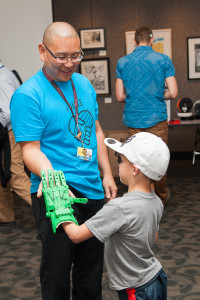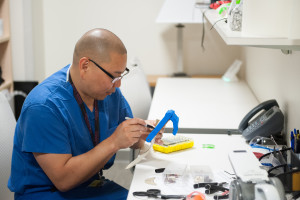WASHINGTON — Griffin Matuszek’s life changed last fall, when the kindergartner traveled from North Bethesda to Baltimore to get a 3-D printed glow-in-the-dark prosthetic hand fit for a superhero — or at the very least, a robotic transformer.
He was the first child to get this type of prosthetic from Dr. Albert Chi, a trauma surgeon at Johns Hopkins Hospital and a volunteer with Enabling the Future (or e-NABLE), a global online network of people with 3-D printers who create inexpensive, colorful prosthetics for kids.

“We call ourselves humanitarian technologists, and we will print anyone in need a hand for free,” says Chi, who spoke with WTOP from the East African nation of Djibouti, where he is deployed with the U.S. Navy Reserve.
Chi has a background in bioengineering and is considered an expert on advanced prosthetics. So when his wife gave him a 3-D printer as a gift, he went online, found free designs and started printing prosthetic hands.
He likens the 3-D printer to a very sophisticated glue gun. “It looks very similar to a standard desktop printer. It just lays layers and layers of plastic down, a layer at a time.”
A traditional prosthetic can cost tens of thousands of dollars, and just like T-shirts and jeans, kids outgrow them at a fairly rapid rate. The 3-D printed hands, however, cost anywhere from $20 to $50 depending on the design, making them easier to replace.
“They are lightweight, they are colorful and these days they have superhero themes,” says Jon Schull, founder of e-NABLE.
The online network Schull created two years ago has grown to 4,700 volunteers. Some, such as Chi, are medical professionals, but most are what Schull calls “digital humanitarians” – people who have access to 3-D printers and produce hands using designs on the e-NABLE web site.
Schull says about 75 percent of the cases that come to e-NABLE are relatively straightforward and involve children, such as Matuszek, who were born without fingers.
For them, these lightweight devices are not only functional, but can also have a profound psychological impact.
“The kids feel like superheroes. They go from being awkward and embarrassed and trying to hide their hand to being the coolest kid in class,” Schull says. “We make children smile, parents weep and we make nerds rejoice.”
But sometimes it happens in a rather roundabout way – such as the time a group of elementary school kids decided to offer a helping hand to a former teacher.

A class of fifth-graders at Western Salisbury Elementary School near Allentown, Pennsylvania, learned about Chi and his work at Johns Hopkins from an online news service. They knew he was printing hands for kids, but wondered if they could convince him to make one for their beloved fourth-grade teacher, Patty Anderson.
Anderson, who lost a hand in an accident when she was a teenager, says the kids launched a letter-writing campaign to Chi and his team at Hopkins that struck a responsive chord.
“Up to this point they had been providing the 3-D printed prosthetics only for children, but he thought he really wanted to respond to the students’ request and make one for me,” Anderson says.
The project took on “a life of its own,” Anderson says, and the doctor not only agreed to the students’ request, but invited all the students, and their current teacher, to accompany Anderson to Johns Hopkins for the big reveal.
“It was so moving,” Chi says. “Everyone was brought to tears when we presented the hand to the teacher.”
The prosthetic was printed in white plastic, and then painted to look like a zebra, at Anderson’s request. But more exciting to her than the design is the fact that the children reached out on her behalf and learned a valuable lesson.
“They learned that even though they are a bunch of 10-year-olds, they really have power to affect change,” Anderson says.
These days, Chi is trying to produce change in East Africa, where he is heading up the surgical unit at a major U.S. military hospital. He says his main goal during his deployment in Djibouti is to serve the troops, but he is also educating the local medical community about 3-D printed prosthetics.
Chi has already asked his team at Hopkins to send some printed hands to Africa, and he is hoping to raise the money to get doctors in Djibouti their very own 3-D printer.
He says the potential to make a difference in the developing world is enormous.
E-NABLE’s Schull says his network of volunteers gets inquiries on a regular basis from overseas, and says 3-D printed hands could very well become a game changer in countries where many people have lost limbs and few can afford a traditional prosthetic.
Video: Watch Griffin Matuszek get his glow-in-the-dark prosthetic hand from Dr. Chi
Editor’s note: This story has been updated to reflect new information from the Matuszek family.







